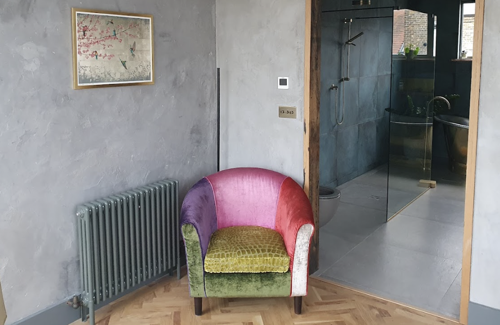When deciding between traditional and modern cast iron radiators, it’s important to consider how each style aligns with a room’s interior design. Traditional radiators boast timeless appeal, featuring intricate detailing and period-specific designs that complement classic or vintage-inspired interiors. Designs characteristic of a specific movement, such as Art Deco or Art Nouveau can serve as a focal point, adding character and warmth to older properties, such as Victorian homes or historic buildings. In contrast, modern radiators offer a sleek aesthetic comprising clean lines and minimalist finishes. Ultimately, the choice between traditional and modern radiators hinges on the interior design vision and whether the space evokes a sense of heritage or embraces contemporary aesthetics.

Modern cast iron radiators can be effectively incorporated into a range of interior design styles, offering versatility across different settings. In contemporary urban apartments, where industrial elements meet modern design, tall and sleek radiators in graphite or metallic finishes complement exposed ductwork and polished concrete floors, adding an edgy yet refined touch. In minimalist spaces with neutral colour palettes, horizontal radiators with smooth surfaces and subtle detailing integrate into the streamlined decor, providing efficient heating without compromising simplicity.
For eclectic interiors that mix styles and textures, modern cast iron radiators offer a versatile canvas for creative expression, whether painted in bold colours or adorned with a decorative cover to blend with furnishings and artworks. In contemporary high-end homes or boutique hotels, large-scale cast iron radiators with luxurious finishes, such as vintage copper or antiqued hammered bronze, bring forth a feeling of grandeur and refinement. Whether in residential, commercial or hospitality settings, modern cast iron radiators offer endless possibilities for enhancing interior spaces with their combination of style, durability and practical heating solutions.
Victorian 9 Column
First produced in America in the 1880s, the Victorian 9 Column has a height of just 33cm. This makes it perfectly suited to conservatories, beneath windows and attic conversions where taller radiators may feel overpowering or visually cluttered.
Rococo 2 Column
One of the earliest decorative models created, the Rococo 2 Column remains a sought-after choice to this day. Drawing inspiration from the Baroque architecture of 17th-century Italy, its design reflects the era's ornate style. Notable features include the scalloped 'eared' top detail and flared feet, creating a cohesive design from top to bottom.
Churchill
The Churchill exudes strength and authority with its bold, robust design. Available in 2 heights, this model boasts exceptional BTU output making it ideal for heating larger rooms. Originally used in government buildings, the Churchill now finds itself at home in traditional and contemporary interiors.
Rathmell 4 Column
The delicate curves between each column demonstrate a paring back in design from the Victorian to Edwardian periods. Available in 3 heights and alternative numbers of columns, Rathmells are incredibly versatile modern cast iron radiators.
Duchess 2 Column
Plump columns and a curved top are the result of traditional cast iron radiators colliding with the Art Nouveau movement. The unique appearance of the Duchess 2 Column makes it a popular choice for modern interiors.
Peerless
Smooth columns are struck with subtle detailing in their central line that runs from top to bottom on the Peerless. Originally used in hospitals, each section has a wider gap making them easy to clean.
Cast iron radiators have been used to heat homes since the 19th century and, while some aspects of manufacturing have evolved with technological advancements, the fundamental process has largely remained the same.
The introduction of smart meters has changed the face of energy management. The devices provide invaluable insights into energy consumption patterns and empower homeowners to make informed decisions about heating and energy usage. Modern cast iron radiators can be paired with smart valves, striking a delicate balance between preserving the charm of a space and embracing energy-saving technologies.
Trads' radiators integrate with smart valves from leading brands such as Hive and Nest. When selecting a smart valve, ensure that both the head and body are equipped with a 1/2" BSP fitting to ensure compatibility across the entire cast iron range. This upgrade modernises the overall heating system, making it more responsive to individual preferences and lifestyle needs. By streamlining heating schedules, unnecessary energy consumption is reduced making a substantial contribution to environmental conservation. Through the fusion of historical heating systems with cutting-edge smart technology, modern cast iron radiators are propelled into an eco-conscious future.
Contacting Trads' customer service team ensures that customers receive comprehensive assistance and guidance when purchasing traditional or modern cast iron radiators. From initial inquiries to post-purchase support, Trads' knowledgeable and friendly representatives are dedicated to providing expert advice on various aspects, including BTU calculation to determine the appropriate radiator size for heating efficiency, recommendations on painting and finishes to match individual preferences and interior décor, as well as guidance on delivery and installation processes.
With a focus on customer satisfaction, Trads' customer service team strives to address any queries or concerns promptly and efficiently, ensuring a smooth and hassle-free experience from start to finish. Call 0800 102 6373, Monday to Friday, to speak with someone directly. Alternatively, ask us a question via our online contact form or email sales@tradscastironradiators.co.uk.
< Back To Blog